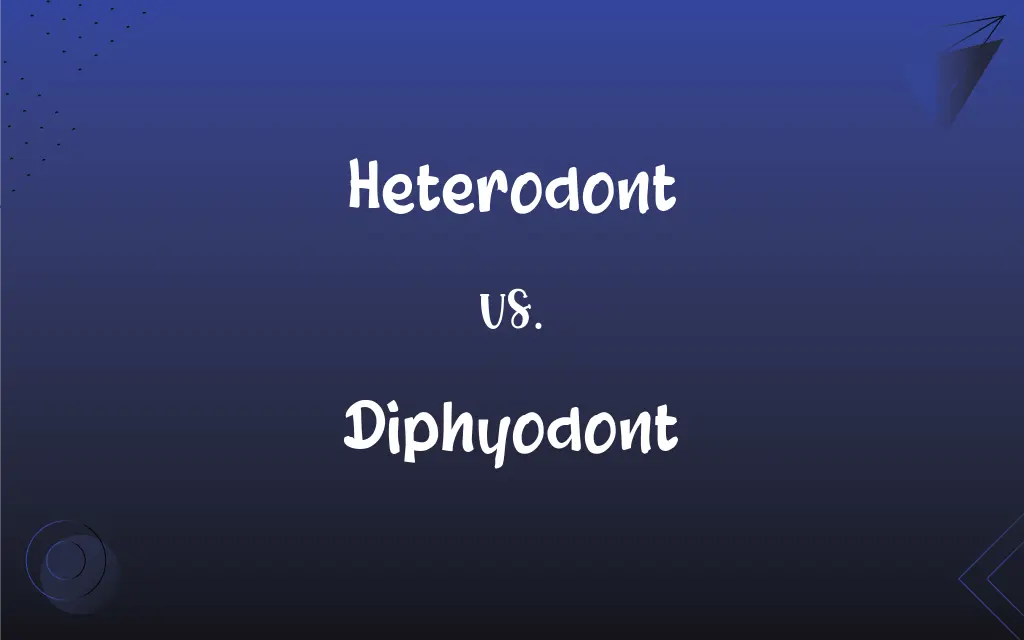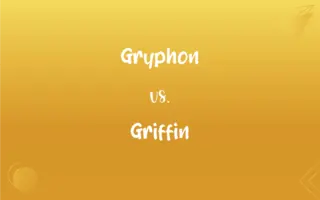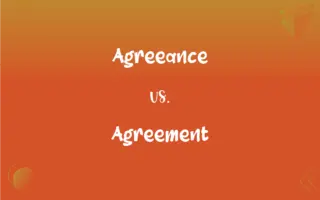Heterodont vs. Diphyodont: What's the Difference?
By Janet White || Updated on May 22, 2024
Heterodont refers to animals with different types of teeth, like incisors and molars, while diphyodont describes animals that have two successive sets of teeth, primary and permanent.

Key Differences
Heterodont dentition means having teeth of different shapes and functions within the same mouth. Examples include mammals like humans who possess incisors, canines, premolars, and molars. This varied tooth structure allows for specialized functions such as cutting, tearing, and grinding food. Diphyodont dentition refers to having two successive sets of teeth throughout an animal's life. Humans are diphyodonts, with a primary set of baby teeth and a secondary set of permanent teeth. This adaptation supports growth, as the first set is replaced to accommodate larger jaws and more developed eating habits.
While heterodonty focuses on the diversity of teeth within a single set, diphyodonty emphasizes the sequential development of two distinct sets of teeth. Heterodonty allows for functional specialization in food processing, whereas diphyodonty ensures teeth replacement as an organism matures.
Animals like humans exhibit both heterodont and diphyodont traits. The heterodont characteristic ensures that different teeth types can perform varied functions, whereas diphyodont nature allows for replacement teeth to maintain dental health and efficiency throughout life.
These dental characteristics are significant in understanding the feeding habits and life stages of various animals. Heterodonty offers insights into dietary specialization, while diphyodonty highlights developmental changes and adaptations in the oral cavity.
Comparison Chart
Definition
Different types of teeth
Two successive sets of teeth
ADVERTISEMENT
Examples
Humans, many mammals
Humans, many mammals
Function
Specialized teeth functions
Teeth replacement over life
Evolutionary Advantage
Dietary specialization
Adaptation to growth and wear
Occurrence
Present in heterodont mammals
Present in diphyodont mammals
Heterodont and Diphyodont Definitions
Heterodont
Found in many vertebrates.
Reptiles and some fish exhibit heterodonty.
ADVERTISEMENT
Diphyodont
Having two sets of teeth in a lifetime.
Humans are diphyodont, starting with baby teeth followed by adult teeth.
Heterodont
Possessing specialized teeth for specific functions.
The heterodont condition helps predators tear and grind their prey.
Diphyodont
Facilitating proper dental function across life stages.
Diphyodonty allows animals to maintain effective chewing surfaces.
Heterodont
Important for diverse diets.
Heterodont dentition allows omnivores to consume both plants and animals.
Diphyodont
Characterized by primary and permanent teeth.
Diphyodont mammals replace their milk teeth as they grow.
Heterodont
Having different types of teeth.
Humans are heterodonts with incisors, canines, premolars, and molars.
Diphyodont
Ensuring dental renewal during growth.
Being diphyodont helps accommodate jaw changes.
Heterodont
Displaying a variety of tooth shapes.
A heterodont mammal can efficiently process various foods.
Diphyodont
Present in most mammals.
Cats and dogs are diphyodont, like humans.
Heterodont
(zootomy) Having teeth of different types (like most mammals).
Diphyodont
Having two successive sets of teeth, deciduous and permanent.
Heterodont
(malacology) Of bivalves or their hinge teeth: having two to three wedge-shaped cardinal teeth set in the centre near the umbones, generally also with elongated lateral teeth on the anterior and posterior margins.
The heterodont arrangement is characteristic of the Venus clams and cockles.
Diphyodont
(anatomy) Having two successive sets of teeth (deciduous and permanent), one succeeding the other.
A diphyodont mammal; diphyodont dentition
Heterodont
(zoology) A heterodont animal.
Diphyodont
Any creature with two successive sets of teeth.
Heterodont
(malacology) A heterodont bivalve.
Diphyodont
Having two successive sets of teeth (deciduous and permanent), one succeeding the other; as, a diphyodont mammal; diphyodont dentition; - opposed to monophyodont.
Heterodont
A snake of the genus Heterodon which is native to North America.
Heterodont
Having the teeth differentiated into incisors, canines, and molars, as in man; - opposed to homodont.
Heterodont
Any animal with heterodont dentition.
FAQs
How many sets of teeth do diphyodont animals have?
Diphyodont animals have two sets of teeth: primary and permanent.
Is a heterodont animal always diphyodont?
Not necessarily, but many heterodont animals, like humans, are also diphyodont.
Can you give an example of a heterodont animal?
Humans are an example of heterodont animals with various types of teeth.
What does heterodont mean?
Heterodont refers to having different types of teeth within the same mouth.
What is diphyodonty?
Diphyodonty is the condition of having two successive sets of teeth during an organism's lifetime.
Why is heterodonty important?
Heterodonty allows for different teeth to perform specialized functions, aiding in varied diets.
Do reptiles exhibit heterodonty?
Yes, some reptiles have heterodont dentition with different types of teeth.
Why do humans have heterodont teeth?
Humans have heterodont teeth to handle various food types through specialized functions.
How many types of teeth are in a heterodont mouth?
Common types include incisors, canines, premolars, and molars.
Are sharks heterodont?
Most sharks are not heterodont; they generally have homodont teeth (all teeth are similar).
What are primary teeth?
Primary teeth are the first set of teeth in diphyodont animals, often called baby teeth.
How does diphyodonty benefit mammals?
Diphyodonty allows mammals to replace worn-out primary teeth with stronger permanent teeth as they grow.
Do diphyodont animals include birds?
No, birds typically do not have teeth and are not diphyodont.
What is a common characteristic of heterodont dentition?
The presence of multiple tooth types for different functions.
Do diphyodont animals include amphibians?
No, most amphibians do not exhibit diphyodonty.
What is the primary advantage of being diphyodont?
The primary advantage is the ability to replace an initial set of teeth with a stronger set suited for adult life.
Can a diphyodont animal have more than two sets of teeth?
No, diphyodont animals only have two sets: primary and permanent.
At what age do diphyodont animals typically lose their primary teeth?
It varies by species; in humans, primary teeth are usually lost between ages 6 and 12.
Are all mammals diphyodont?
Most mammals are diphyodont, but some exceptions exist.
Is heterodonty unique to mammals?
No, heterodonty is also found in other vertebrates like some reptiles.
About Author
Written by
Janet WhiteJanet White has been an esteemed writer and blogger for Difference Wiki. Holding a Master's degree in Science and Medical Journalism from the prestigious Boston University, she has consistently demonstrated her expertise and passion for her field. When she's not immersed in her work, Janet relishes her time exercising, delving into a good book, and cherishing moments with friends and family.































































